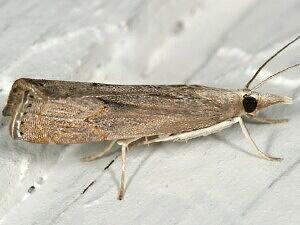When you think of pollination, you often think of butterflies or bees flying around your garden. While these insects are important to flowers and our food supplies, new research shows just how much plants and crops rely on insects that fly at night for pollination.
Most flowering plants count on pollinators for reproduction. Recent years have seen a dramatic drop in pollinator populations. The factors behind the loss have been linked to habitat loss, pesticides and climate change. Research estimates 3-5% of fruit; nut and vegetable crop production is lost globally due to inadequate pollination.
A recent study at the University of Sussex, UK, discovered moths are more efficient pollinators than bees. The team studied both daytime and nocturnal pollinator visits. They discovered that while 83% of all pollinator visits occur during the day (with 17% at night), it also found moths were able to pollinate flowers more quickly than daytime insects!
The reason nocturnal moths are more efficient pollinators is that moths collect so much static electricity while in flight that pollen is pulled through the air to them. The researchers noted that moths do not need to touch flowers in order to pollinate them. The pollen is pulled across the air gaps as the moths fly several millimeters or even centimeters above.
The researchers concluded nocturnal pollination is understudied. As moths have been shown to transport pollen from a wide variety of plant species, further research is needed to fully appreciate the role they and other nocturnal insects play.
To understand just the important role moths play in pollination, the University of Sheffield, UK, found moths account for a third of all urban pollination. However, a lack of native plant species and diversity of plant life in cities, coupled with scent-stifling air pollution, is still leaving moths struggling to find their next meal.
And finally, experts are warning of an “alarming” global decline in moth population and diversity.
In general, most moths have feathery antennae. At rest, their wings are often folded flat across their backs. Their bodies tend to be plumper and sometimes look furry. Moths fly at night and during twilight hours. In general they are very short-lived, with some only lasting a few days.
To highlight the importance of moths as pollinators, TLCNP has held two evening moth roundups. Below is a list of nighttime flying insects that were seen those evenings.
Black Moth?
Seen at TLCNP on April 2025.
Black-bordered Lemon Moth
Seen at TLCNP on April 2025.
Bluegrass Webworm Moth
The wingspan is about 1 inch. Adults are on wing from May to October in two generations per year. The larvae feed on native and Bermuda grasses. This moth can be found from New England to Florida and as far west as New Mexico. It likes lawns, golf courses, grassy areas in general. Seen at TLCNP on November 2024.
Bluegrass Moth
Dark Sod Webworm moth
Most sod webworms are native to North America and are widely distributed within the continental United States. This species can be found from Texas to Colorado. Adult moths are 0.5 to 0.75 inch wingspan. They have a snout-like projection on the head. When disturbed they fly short distances in a zigzag pattern. They are usually seen in the early morning hours flying over dark-green healthy grass. Seen at TLCNP on November 2024.
Dark Sod Webworm
Eight-Spot Moth
This moth is a species of owlet moth that is found in southern North America, from Florida to Arizona. It migrates north to Canada in late summer and fall.
The larvae feed on several types of perennial plants, hibiscus, sunflowers and hackberries. The adult moth is chocolate brown above and has a wingspan of 1 inch. The forewings have faint greyish-white lines and an obscure figure-of-eight mark on it. Adults are on wing from August to October. Seen at TLCNP on November 2024.
Eight-spot Moth
Twirler Moth
These are generally very small moths with narrow, fringed wings. The larvae of most species feed internally on various parts of their host plants, sometimes causing galls. The adults take flight year round. This moth can be found from Texas to Florida. Seen at TLCNP on November 2024.
Twirler Moth
Dirt-colored Seed Bug
This is a common name for over 2,100 small bugs. These can be found in North, Central and South America. They are very common in the Southern United States. They can be easily identified by the white triangle in the middle of their wings. They generally feed on seeds from a wide variety of plants.
They are often called true bugs. True Bugs are insects that have two pairs of wings, an outer pair and inner pair. The outer wing covers are held over the back and often partly folded. True bugs have hypodermic-needle-like mouthparts that allow them to extract subsurface fluids from plants and animals. True Bugs undergo incomplete metamorphosis, with their young looking similar to adults, but without wings. Seen at TLCNP on November 2024.
Rain Click Beetle
This small beetle is a rare find. It can be found in eastern and southern Texas. It likes to swarm after a rain. The swarming period is always late in the year, Oct-Dec. Seen at TLCNP on November 2024.
Rain Click Beetle








